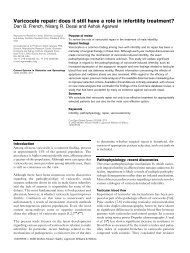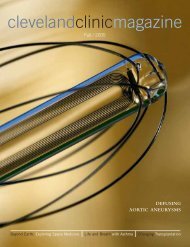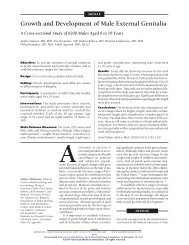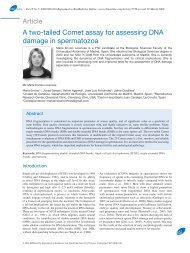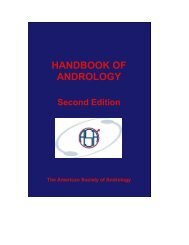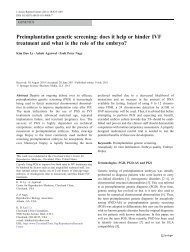Artificial Insemination
Artificial Insemination
Artificial Insemination
Create successful ePaper yourself
Turn your PDF publications into a flip-book with our unique Google optimized e-Paper software.
Ch36-A03309.qxd 1/23/07 5:16 PM Page 540<br />
Section 6<br />
Infertility and Recurrent Pregnancy Loss<br />
540<br />
technique was found to result in pregnancy rates 2 to 3 times<br />
those of intracervical insemination. However, intracervical<br />
insemination is still utilized in some practices. 5<br />
In an effort to further improve pregnancy rates, techniques<br />
were developed to place washed sperm samples directly into the<br />
tubes via transcerival cannulation (intratubal insemination) or<br />
into the peritoneal cavity via a needle placed through the posterior<br />
cul-de-sac (intraperitoneal insemination). Another technique<br />
developed in Europe, termed fallopian tube sperm perfusion,<br />
involves pressure injection of a large volume (4 mL) of washed<br />
sperm sample while the cervix is sealed to prevent reflux of the<br />
sample. 6 This technique appears to have a higher pregnancy rate<br />
than IUI in couples with unexplained infertility. The remainder<br />
of these technically difficult approaches have never been shown<br />
to result in better pregnancy rates than IUI. One prospective,<br />
randomized study found that simultaneous intratubal insemination<br />
actually decreased the pregnancy rates associated with IUI. 7<br />
In modern clinical practice in the United States, IUI is the<br />
predominant technique used for artificial insemination.<br />
EVALUATION<br />
Male Evaluation<br />
Semen Analysis<br />
The male partner is initially evaluated by obtaining a complete<br />
semen analysis and screen for sperm antibodies. A minimum of<br />
two samples provided over 1 to 2 months is analyzed. A third<br />
sample may be required if there is a discrepancy between<br />
the initial samples. All samples should be provided after 48 to<br />
72 hours of sexual abstinence. Samples should be analyzed within<br />
2 hours of collection.<br />
Antisperm Antibodies<br />
Male antisperm antibodies are found in approximately 10% of<br />
semen samples from infertile couples. Men with antisperm antibodies<br />
attached to their sperm are classified as having immunologic<br />
infertility. These antibodies are believed to decrease fertility by<br />
inducing agglutination or immobilization of the sperm. Studies<br />
have identified multiple antisperm antibodies that correspond to<br />
a variety of sperm components.<br />
There are multiple known risk factors for the development of<br />
male antisperm antibodies. 8 Vasectomy results in the development<br />
of antisperm antibodies in the majority of men. After successful<br />
vasovasostomy, more than half of these men will have detectable<br />
sperm-bound antibodies. The pregnancy rates will depend on<br />
many factors, including the titer and quantity of gross agglutination.<br />
Obstructive azospermia from any cause (e.g., congenital absence<br />
of the vas deferens, cystic fibrosis, infant hernia repair) increases<br />
the risk of antisperm antibodies. Reproductive infections (e.g.,<br />
epididymitis, prostatitis, or orchitis) are also associated with<br />
antisperm antibodies.<br />
Antisperm antibody tests are performed as a routine part of<br />
a complete semen analysis during the initial infertility evaluation.<br />
The most commonly used test in clinical practice is probably the<br />
immunobead assay. 8 This quantitative assay evaluates live sperm<br />
and indicates percent bound, antibody isotype, and binding<br />
location. For routine screening, some andrology laboratories<br />
use a commercially available mixed antiglobulin reaction assay<br />
(SpermMar).<br />
Male subfertility is significantly increased when the antisperm<br />
antibody level is greater than 50%. 9,10 Antisperm antibodies<br />
interfere with sperm–zona pellucida binding and prevent embryo<br />
cleavage and early development.<br />
Complete Evaluation<br />
In the presence of persistently abnormal results on semen<br />
analysis, a complete history, physical examination, and laboratory<br />
evaluation is performed to find and treat any potentially reversible<br />
abnormalities (see Chapter 35).<br />
Female Evaluation<br />
The female partner should undergo a basic infertility evaluation<br />
so that any correctable factors can be identified and treated<br />
before artificial insemination (see Chapter 34). In addition to a<br />
detailed history and physical examination, each woman considering<br />
partner or donor insemination should be evaluated with<br />
an imaging technique, usually a hysterosalpingogram, to document<br />
patent tubes. Unless oral or injectable medications are used to<br />
induce superovulation, ovulatory function should be evaluated<br />
with a urinary luteinizing hormone (LH) detection kit and midluteal<br />
serum progesterone level. Further evaluation is required<br />
in the event of detection of any clinical or laboratory abnormalities.<br />
In the past, a great deal of time was spent investigating the<br />
possibility of cervical factor infertility by evaluating the character<br />
and sperm survivability in periovulatory cervical mucus, using<br />
what is termed a postcoital test. This test had many false-positive<br />
results, because it depended more on timing in the cycle and<br />
hormonal status than on static cervical characteristics. Except<br />
for exclusion of cervicitis during pelvic examination, timed<br />
evaluation of cervical mucus and sperm interaction is infrequently<br />
included in a fertility examination. This is because partner IUI<br />
is used as a basic fertility enhancement method for the majority<br />
of couples who have otherwise been unable to conceive regardless<br />
of diagnosis.<br />
INDICATIONS<br />
Partner <strong>Insemination</strong><br />
Partner insemination was originally developed as a treatment for<br />
male factor infertility. With the advent of IUI, partner insemination<br />
has been found to be an excellent treatment for a range of diagnoses,<br />
including cervical factor infertility, unexplained infertility,<br />
and subfertility, on the basis of other diagnoses or therapeutic<br />
measures (Table 36-2). This ability of partner insemination to<br />
increase pregnancy rates regardless of diagnosis has made this<br />
technique one of the fundamental approaches to infertility<br />
treatment today.<br />
Male Factor Infertility<br />
Partner insemination appears to be of clear benefit when the<br />
couple’s infertility is the result of any condition that makes it<br />
difficult to place semen high in the vagina during coitus. Male<br />
conditions resulting in this situation are termed ejaculatory failure.<br />
The most common causes of ejaculatory failure are impotence,<br />
severe hypospadias, and retrograde ejaculation. A unique condition<br />
that has been found to be treatable with artificial insemination<br />
is impotence secondary to spinal cord injury. 11



